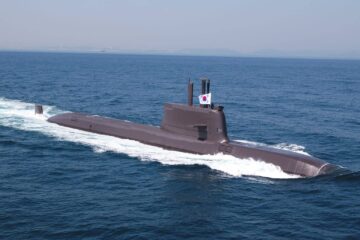The other seven SLBM-armed states are the United States, Russia, the United Kingdom, France, India, China, and North Korea. Seoul has enhanced its ballistic missile capabilities, especially the K-SLBM labeled as Hyunmoo 4-4, as a countermeasure against the North Korean SLBM Pukguksong series shown in a military parade in the beginning of this year.
According to an informed source from the defense industry, the Agency for Defense Development (ADD) succeeded confidential tests twice that launched an SLBM from the first 3000 tons KSS III submarine Dosan Ahn Chang-ho which was commissioned with the ROK Navy last month. The key SLBM technology, called ‘cold launch’ that ignites a missile engine after pushing water out of the launcher with air pressure, reportedly functioned with success in the test. A person from the ADD informed the press, “The last and third launch test in the middle of September will finally lead to SLBM production and deployment at sea.” The last launch test will be conducted to ensure accuracy, at the near sea around the ADD’s Anheung testing facility in South Chungcheong province, without inviting the media.
The SLBM development is composed of the total three phases: ground launch, underwater launch, and submarine launch. The ROK Navy succeeded both ground and underwater tests, respectively in the end of last year and in July this year. KSS Dosan Ahn Chang-ho will be able to carry 6 SLBMs. The ROK-U.S. missile guidelines lifted after the summit talk in Washington in May paved the way for K-SLBM development. South Korea is now able to acquire any types of ballistic missiles regardless of payloads or firing range.
The local media reported this development as a stepping stone for the ROK military, since the SLBM is known as a ‘game changer’. However, it was also reported that the Moon administration that seeks to appease North Korea and improve the inter-Korean relations while simultaneously preparing for self-reliable military capabilities to reclaim the wartime operation control from the U.S. forces during the remaining 6 months of the presidential term, seems to keep silent about this military achievement due to the concern of provoking the North. In regard to this, Seoul decided not to release the success of the last phase of submarine launch test today, as done so far regarding SLBM tests.
The Ministry of National Defense and the Korean military still maintain the stance that secretive projects are impossible to be confirmed officially. The MND did not specifically mention its SLBM development in the press release about the ‘2022-2026 Mid-term Defense Plan’, only stating that strategic deterrence capabilities will be continuously strengthened by acquiring mid-sized submarines that could destroy ground strategic targets with precision strike.
To learn more about the significance of this event, check out this analysis by H I Sutton:






